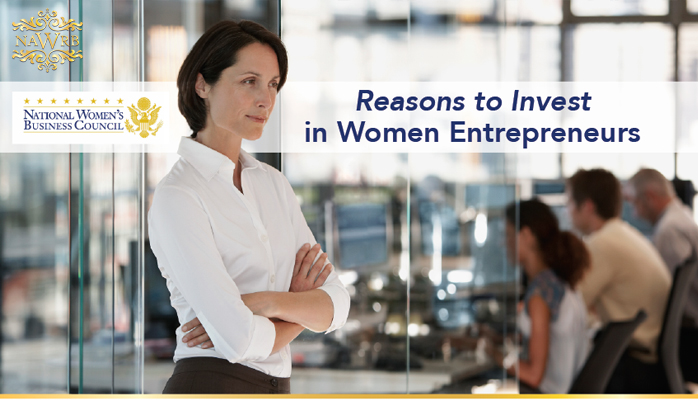The National Women’s Business Council (NWBC), a non-partisan federal advisory council that advises the President, Congress and the U.S. Small Business Administration on economic issues concerning women business owners, recently released their Reasons to Invest in Women Entrepreneurs fact sheet:
Women-owned firms are a vital component of the economy. As of 2012, the United States had approximately 9 million privately-held women-owned firms. Firms owned by women are responsible for approximately $1.4 trillion in sales. 11.7% have employees other than the owner, and these firms employ 7.8 million people.
There are many reasons we should invest in and support the growth of women-owned and women-led ventures. Here are our top 5:
- Women-owned firms spur economic growth.
Investing in women-owned firms goes beyond social responsibility and has profound economic impacts on the U.S. economy. Women-owned firms result in increased jobs, and yield substantial sales and receipts.
- Since 1997, women-owned firms have continuously generated jobs that ultimately result in economic growth. During this same time period, women-owned firms witnessed an increase of 510,939 jobs.
- From 1997 to 2007, the number of women-owned firms increased by 2,376,391 which resulted in an increase in receipts of $37.4 billion.
- Total sales/receipts of women-owned privately held firms totaled $1.2 trillion in 2007. This represented 46% growth from 2002 compared to 28% growth among men–owned firms.
- Women-owned and women-led firms exhibit stronger financial performance.
Despite less access to capital, women-owned and women-led firms have higher levels of financial performance compared to exclusively men-owned firms.
- In Fortune 500 companies, firms that had at least three women board directors (WBDs) for at least five years, outperformed those with zero WBDs by 84% on return on sales (ROS), 60% on return on invested capital (ROIC) and 46% on return on equity (ROE).
- Women-friendly firms (high number of WBDs) outperformed industry median firms in percent of revenues, assets and stockholder’s equity by 1.6 percent. “The women-friendly firms averaged 6.4 percent while the average of their industry medians was 4.8 percent.”
- On average, the likelihood of success of venture-backed companies increases with more women in high ranking positions. “The overall median proportion of female executives is 7.1% at successful companies and 3.1% at unsuccessful companies.” Firms with one or more women executives are more likely to turn a profit, go public, or sell for greater money than raised.
- Robb and Watson “found no significant difference in the performances of female- and male-owned new ventures with respect to overall (4-year) survival rates, return on assets (ROA), or in risk-adjusted terms (Sharpe ratio). These results should dispel the myth that female-owned firms underperform male-owned firms simply because they are smaller, or because females prefer to take fewer risks.”
3. Women’s leadership leads to increased innovation.
Women and men bring varying perspectives to leadership. Gender diversity can allow for a wider knowledge base and original thinking; ultimately, it spurs innovation.
- Higher proportions of women at top levels of management are associated with increased levels of innovation intensity.
- Studies have concluded that increased levels of diversity in the management team promote business performance because it is associated with higher levels of innovation, market orientation, and entrepreneurship.
- Increased levels of diversity in management are linked with the “development and implementation of major products.”
- Women serve women consumers better, which is important because women consumers control the majority of purchases in the consumer market.
Women consumers are critical for ensuring a thriving economy. Often, women are more connected with the needs of other women and as such, women-owned and women-led firms are more likely to design products and services that meet those needs.
- Women consumers are responsible for approximately $7 trillion in spending power in the United States. Since they represent 51% of the population, the needs of women consumers are vital to our economic system.
- Of the 161 million women in the United States, 74.9% of women identify themselves as the primary shoppers.
- Additionally, women in the U.S. reported “controlling” 72.8% of household spending
- Research conducted by Walmart “found 90 percent of female customers in the US would go out of their way to purchase products from women, believing they would offer higher quality.”
- Women also bring in half or more of the income in 55% of U.S. households. And women ages 50 and older control a net worth of $19 trillion and own more than three-fourths of the nation’s financial wealth, according to MassMutual Financial Group.
- The time to invest in women is now.
Women’s entrepreneurial appetites are at an all-time high; approximately 1,200 new businesses a day are started by women. The United States is witnessing more ecosystems of innovative solutions that nurture women founders and owners, and responsible marketplaces that understand the strengths of women in business.
- Women-focused investment firms are growing. Golden Seeds and Texas Women Ventures are examples; Golden Seeds has invested over $70 million in more than 65 women-led businesses.
- Equity crowdfunding platforms are giving women unprecedented access to capital. Examples include Plum Alley, a woman by woman platform and Indiegogo where 42% of the successful crowdfunding campaigns are run by women.
- Microloan programs such as ACCION International, Grameen America, Kiva, and Opportunity Fund can help provide both capital and technical assistance. This fosters performance by women businesses by not only increasing their available capital but also improving their business expertise.
- New ventures owned by women and those owned by men experience no difference in performance. Thus women who are “contemplating starting a new venture [should] not be discouraged from doing so by a false belief that new ventures initiated by women are less likely to succeed than those initiated by men.”
NAWRB is a proud supporter of the NWBC’s mission to improve opportunities for women business owners. To learn more about the NWBC, or read other recently released fact sheets, please visit http://nwbc.gov/content/three-new-fact-sheets.

 Login
Login

